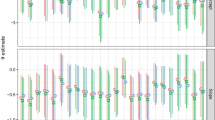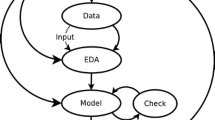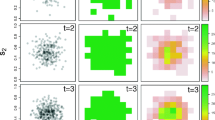Abstract
During the 20th century ecologists largely relied on the frequentist system of inference for the analysis of their data. However, in the past few decades ecologists have become increasingly interested in the use of Bayesian methods of data analysis. In this article I provide guidance to ecologists who would like to decide whether Bayesian methods can be used to improve their conclusions and predictions. I begin by providing a concise summary of Bayesian methods of analysis, including a comparison of differences between Bayesian and frequentist approaches to inference when using hierarchical models. Next I provide a list of problems where Bayesian methods of analysis may arguably be preferred over frequentist methods. These problems are usually encountered in analyses based on hierarchical models of data. I describe the essentials required for applying modern methods of Bayesian computation, and I use real-world examples to illustrate these methods. I conclude by summarizing what I perceive to be the main strengths and weaknesses of using Bayesian methods to solve ecological inference problems.





Similar content being viewed by others
Notes
I use bracket notation (Gelfand and Smith 1990) to specify probability density functions; thus, [x, y] denotes the joint density of random variables X and Y, [x | y] denotes the conditional density of X given \(Y=y\), and [x] denotes the unconditional (marginal) density of X.
References
Bayes T (1763) An essay towards solving a problem in the doctrine of chances. Philos Trans R Soc 53:370–418
Berger JO (2006) The case for objective Bayesian analysis. Bayesian Anal 1:385–402
Box GEP (1980) Sampling and Bayes inference in scientific modelling and robustness (with discussion). J Royal Statist Soc Ser A 143:383–430
Box GEP, Tiao GC (1973) Bayesian inference in statistical analysis. Addison-Wesley, Reading
Brooks S, Gelman A, Jones GL, Meng XL (eds) (2011) Handbook of Markov chain Monte Carlo. Chapman & Hall / CRC, Boca Raton, Florida
Buckland ST, Newman KB, Fernández C, Thomas L, Harwood J (2007) Embedding population dynamics models in inference. Stat Sci 22:44–58
Clark JS (2007) Models for ecological data: an introduction. Princeton University Press, Princeton
Diggle PJ, Tawn JA, Moyeed RA (1998) Model-based geostatistics (with discussion). Journal of the Royal Statistical Society. C (Applied Statistics) 47:299–350
Dorazio RM, Taylor Rodríguez D (2012) A Gibbs sampler for Bayesian analysis of site-occupancy data. Methods Ecol Evol 3:1093–1098
Draper D (1996) Utility, sensitivity analysis, and cross-validation in Bayesian model-checking. Stat Sinica 6:760–767
Efron B (2005) Bayesians, frequentists, and scientists. J Am Stat Assoc 100:1–5
Flegal JM, Jones GL (2010) Batch means and spectral variance estimators in Markov chain Monte Carlo. Ann Stat 38:1034–1070
Flegal JM, Jones GL (2011) Implementing MCMC: estimating with confidence. In: Brooks S, Gelman A, Jones GL, Meng XL (eds) Handbook of Markov chain Monte Carlo, Chapman & Hall / CRC. Florida, Boca Raton, pp 175–197
Gelfand AE, Smith AFM (1990) Sampling-based approaches to calculating marginal densities. J Am Stat Assoc 85:398–409
Gelman A (2011) Induction and deduction in Bayesian data analysis. Rational Markets Morals 2:67–78
Gelman A, Shirley K (2011) Inference from simulations and monitoring convergence. In: Brooks S, Gelman A, Jones GL, Meng XL (eds) Handbook of Markov chain Monte Carlo, Chapman & Hall / CRC. Florida, Boca Raton, pp 163–174
Gelman A, Meng XL, Stern H (1996) Posterior predictive assessment of model fitness via realized discrepancies (with discussion). Stat Sinica 6:733–807
Geyer CJ (2011) Introduction to Markov chain Monte Carlo. In: Brooks S, Gelman A, Jones GL, Meng XL (eds) Handbook of Markov chain Monte Carlo, Chapman & Hall / CRC. Florida, Boca Raton, pp 3–48
Hobert JP (2011) The data augmentation algorithm: theory and methodology. In: Brooks S, Gelman A, Jones GL, Meng XL (eds) Handbook of Markov chain Monte Carlo. Chapman & Hall / CRC, Boca Raton, Florida, pp 253–293
Hooten MB, Hobbs NT (2015) A guide to Bayesian model selection for ecologists. Ecol Monogr 85:3–28
Hooten MB, Wikle CK (2007) A hierarchical bayesian non-linear spatio-temporal model for the spread of invasive species with application to the Eurasion collared-dove. Environ Ecol Stat 15:59–70
Jeffreys H (1961) Theory of probability, 3rd edn. Oxford University Press, New York
Johnson DS, Conn PB, Hooten MB, Ray JC, Pond BA (2013) Spatial occupancy models for large data sets. Ecology 94:801–808
Kéry M, Schaub M (2012) Bayesian population analysis using WinBUGS. Academic Press, Waltham
Kéry M, Dorazio RM, Soldaat L, van Strien A, Zuiderwijk A, Royle JA (2009) Trend estimation in populations with imperfect detection. J Appl Ecol 46:1163–1172
King R, Morgan BJT, Gimenez O, Brooks SP (2010) Bayesian analysis for population ecology. Chapman and Hall/CRC, Boca Raton
Laird NM, Louis TA (1987) Empirical Bayes confidence intervals based on bootstrap samples (with discussion). J Am Stat Assoc 82:739–757
Laird NM, Ware JH (1982) Random-effects models for longitudinal data. Biometrics 38:963–974
Laplace PS (1774a) Memoir on the probability of the causes of events. Stat Sci 1:364–378 (English translation of the French original by S. M. Stigler in 1986)
Laplace PS (1774b) A philosophical essay on probabilities. John Wiley & Sons, New York (English translation of the French original by F. W. Truscott and F. L. Emory in 1902)
Lindley DV (2000) The philosophy of statistics (with discussion). Statist 49:293–337
Link WA, Barker RJ (2010) Bayesian inference. Academic Press, Amsterdam
Little R (2011) Calibrated Bayes, for statistics in general, and missing data in particular. Stat Sci 26:162–174
Little RJ (2006) Calibrated Bayes: a Bayes/frequentist roadmap. Am Stat 60:213–223
Little RJA, Rubin DB (2002) Statistical analysis with missing data, 2nd edn. Wiley, Hoboken
MacKenzie DI, Nichols JD, Lachman GB, Droege S, Royle JA, Langtimm CA (2002) Estimating site occupancy rates when detection probabilities are less than one. Ecology 83:2248–2255
MacKenzie DI, Nichols JD, Royle JA, Pollock KH, Bailey LL, Hines JE (2006) Occupancy estimation and modeling. Elsevier, Amsterdam
McCarthy M (2007) Bayesian methods for ecology. Cambridge University Press, Cambridge
McCarthy MA, Masters P (2005) Profiting from prior information in Bayesian analyses of ecological data. J Appl Ecol 42:1012–1019
Morris CN (1983) Parametric empirical Bayes inference: theory and applications (with discussion). J Am Stat Assoc 78:47–65
Morris WK, Vesk PA, McCarthy MA (2013) Profiting from prior studies: analysing mortality using Bayesian models with informative priors. Basic Appl Ecol 14:81–89
Nichols JD, Pollock KH, Hines JE (1984) The use of a robust capture-recapture design in small mammal population studies: A field example with Microtus pennsylvanicus. Acta Theriol 29:357–365
Parent E, Rivot E (2013) Introduction to hierarchical Bayesian modeling for ecological data. Chapman and Hall/CRC, Boca Raton
Robert C, Casella G (2011) A short history of MCMC: subjective recollections from incomplete data. In: Brooks S, Gelman A, Jones GL, Meng XL (eds) Handbook of Markov chain Monte Carlo. Chapman & Hall / CRC, Boca Raton, Florida, pp 49–66
Royle JA, Dorazio RM (2006) Hierarchical models of animal abundance and occurrence. J Agr Biol Environ Stat 11:249–263
Royle JA, Dorazio RM (2008) Hierarchical modeling and inference in ecology. Academic Press, Amsterdam
Royle JA, Dorazio RM (2012) Parameter-expanded data augmentation for Bayesian analysis of capture-recapture models. J Ornithol 152:S521–S537
Royle JA, Wikle CK (2005) Efficient statistical mapping of avian count data. Environ Ecol Stat 12:225–243
Rubin DB (1984) Bayesianly justifiable and relevant frequency calculations for the applied statistician. Ann Stat 12:1151–1172
Schaub M, Abadi F (2011) Integrated population models: a novel analysis framework for deeper insights into population dynamics. J Ornithol 152:S227–S237
Tanner MA (1996) Tools for statistical inference: methods for the exploration of posterior distributions and likelihood functions, 3rd edn. Springer-Verlag, New York
Tyre AJ, Tenhumberg B, Field SA, Niejalke D, Parris K, Possingham HP (2003) Improving precision and reducing bias in biological surveys: estimating false-negative error rates. Ecol Appl 13:1790–1801
Walters JR, Beissinger SR, Fitzpatrick JW, Greenberg R, Nichols JD, Pulliam HR, Winkler DW (2000) The AOU conservation committee review of the biology, status, and management of Cape Sable seaside sparrows: final report. Auk 117:1093–1115
Wikle CK (2003) Hierarchical Bayesian models for predicting the spread of ecological processes. Ecology 84:1382–1394
Wikle CK (2010) Hierarchical modeling with spatial data. In: Gelfand AE, Diggle PJ, Fuentes M, Guttorp P (eds) Handbook of spatial statistics. Chapman & Hall / CRC, Boca Raton, Florida, pp 89–106
Williams BK, Nichols JD, Conroy MJ (2002) Analysis and management of animal populations. Academic Press, San Diego, California
Acknowledgments
I thank Dr. Yukihiko Toquenaga for inviting me to present this article in a plenary symposium of the 30th Annual Meeting of the Society of Population Ecology in Tsukuba, Japan. I am also grateful to the Society and to the University of Tsukuba for providing funding for my travel expenses and publication costs. Chris Wikle and two anonymous referees kindly provided suggestions that improved an earlier draft of this article. Any use of trade, product, or firm names is for descriptive purposes only and does not imply endorsement by the U.S. Government.
Author information
Authors and Affiliations
Corresponding author
Additional information
This manuscript was submitted for the special feature based on a symposium in Tsukuba, Japan, held on 11 October 2014.
Electronic supplementary material
Below is the link to the electronic supplementary material.
Rights and permissions
About this article
Cite this article
Dorazio, R.M. Bayesian data analysis in population ecology: motivations, methods, and benefits. Popul Ecol 58, 31–44 (2016). https://doi.org/10.1007/s10144-015-0503-4
Received:
Accepted:
Published:
Issue Date:
DOI: https://doi.org/10.1007/s10144-015-0503-4




